Great Sand Dunes National Park Day Trip Guide
There seems to be a gravitational pull between mountains and sand dunes that irresistibly calls out to me. Every time I glance at the photos and recall my cherished visit to Great Sand Dunes National Park, I can hear them beckoning me to return.
GREAT SAND DUNES NATIONAL PARK
Where else in North America can you find towering sand dunes, hundreds of feet high, set against the backdrop of snow-capped mountains stretching to the horizon? Welcome to Great Sand Dunes National Park and Preserve.
Initially designated as a National Monument by President Hoover in 1932, the park was granted full National Park status in September 2004, making it one of the newest National Parks, protecting over sixty-five square miles of this extraordinary landscape.
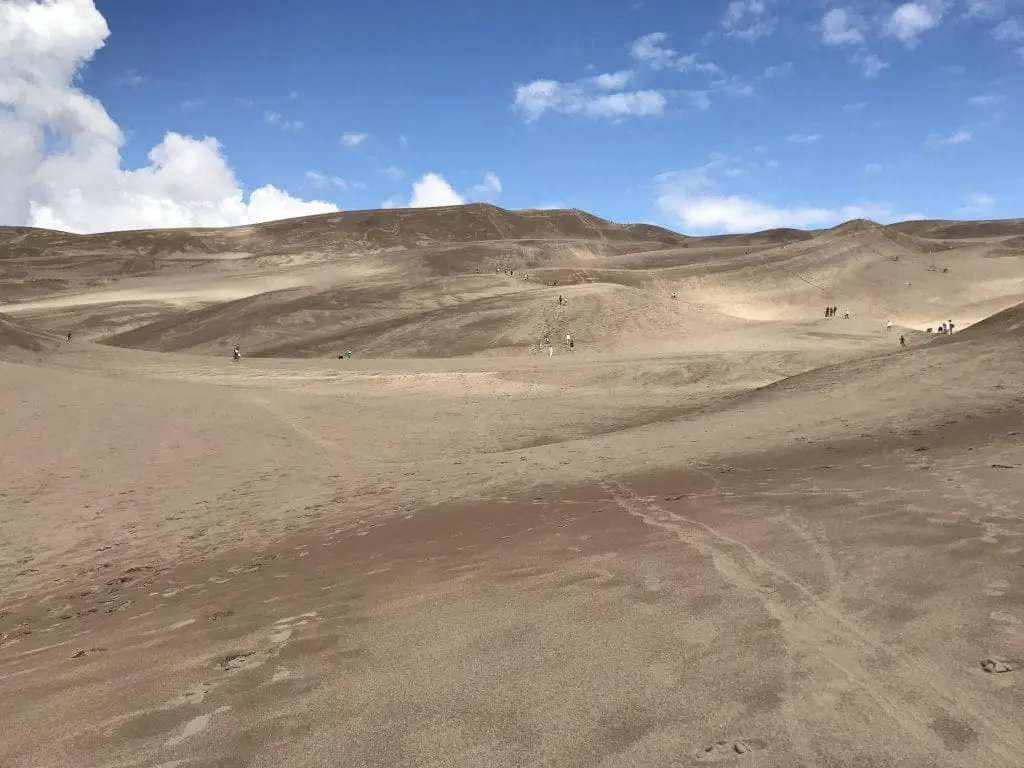
The dunes in Colorado are truly colossal, representing the largest dunes in North America. It’s always an astonishing experience to explore this magnificent sand park; as you climb one dune, another even taller and larger one appears on the horizon.
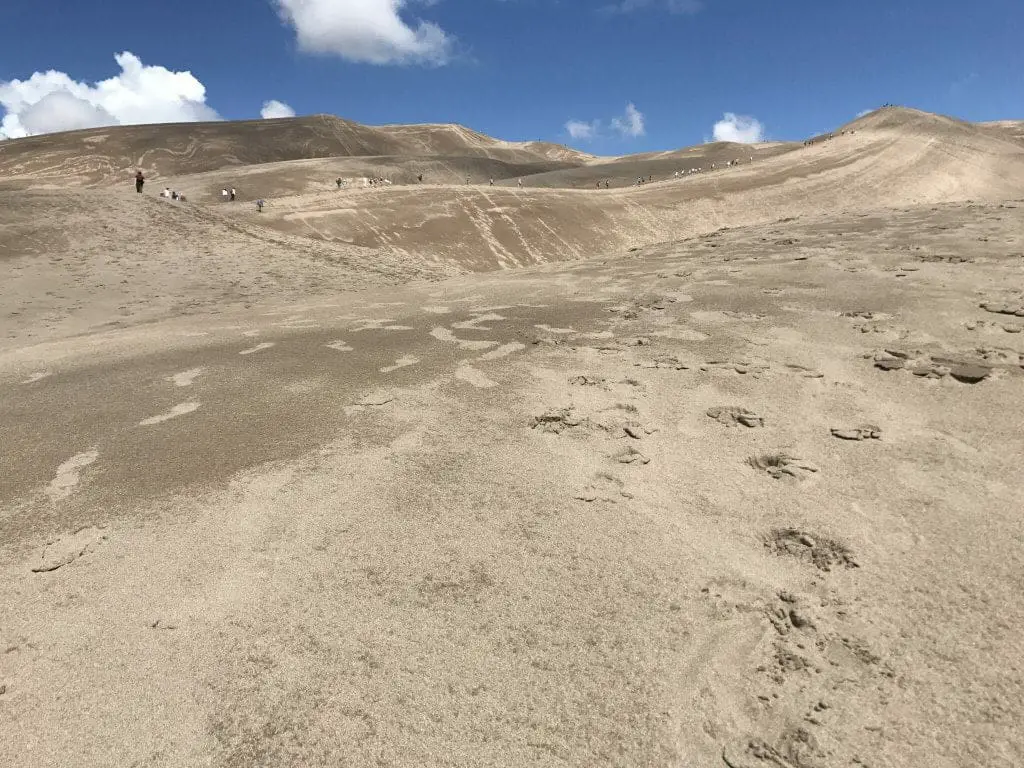
It’s striking out here! I was humbled and amazed seeing the work of erosion, wind, and abrasion sculpting these massive dunes. Mother nature packs so many surprises and these dunes are one of her best.
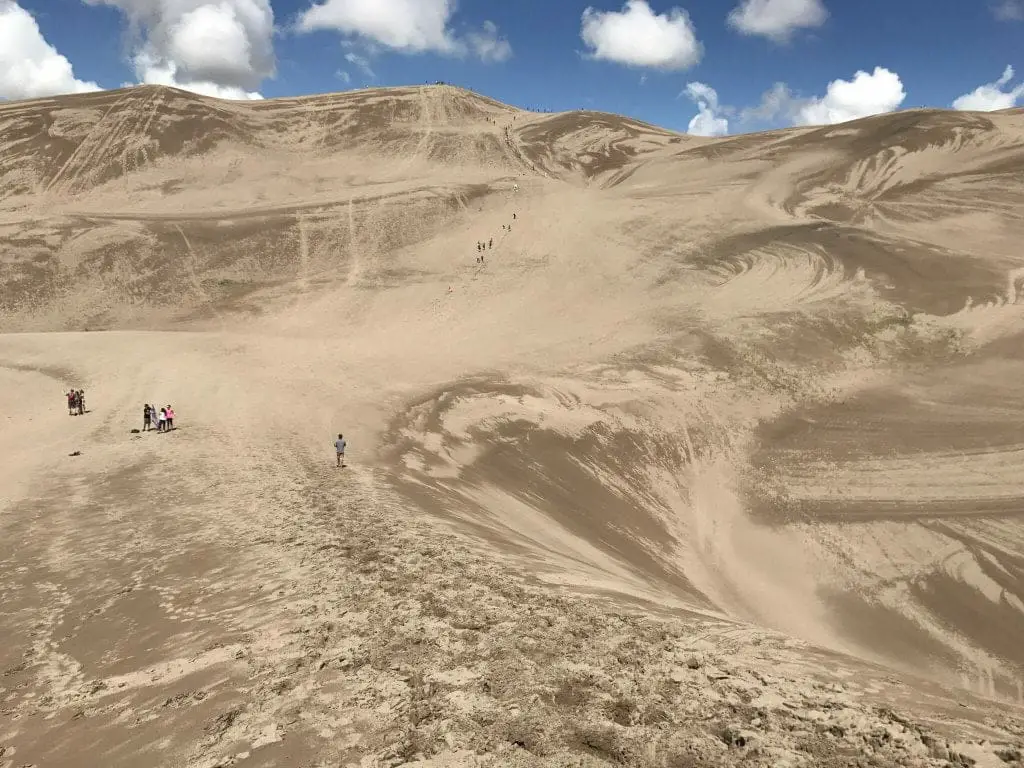
Arriving at Great Sand Dunes
Driving into southern Colorado, winding through the burgeoning mountains, you enter the expansive San Luis Valley in eastern Alamosa County, once a glacial lake. In the distance, fuzzy hills gradually reveal themselves as the Great Sand Dunes of Southern Colorado.
Approaching them, their sheer size engulfs you, beckoning exploration. This geological wonder exists due to a confluence of natural elements and prevailing winds that funnel toward a dip in the Sangre de Cristo Range. Here, sand from the valley converges, causing the dunes to rise vertically. The spectacle of physical forces at play in nature, building the neighboring mountain ranges and grinding them down to create the dunes, is truly remarkable.
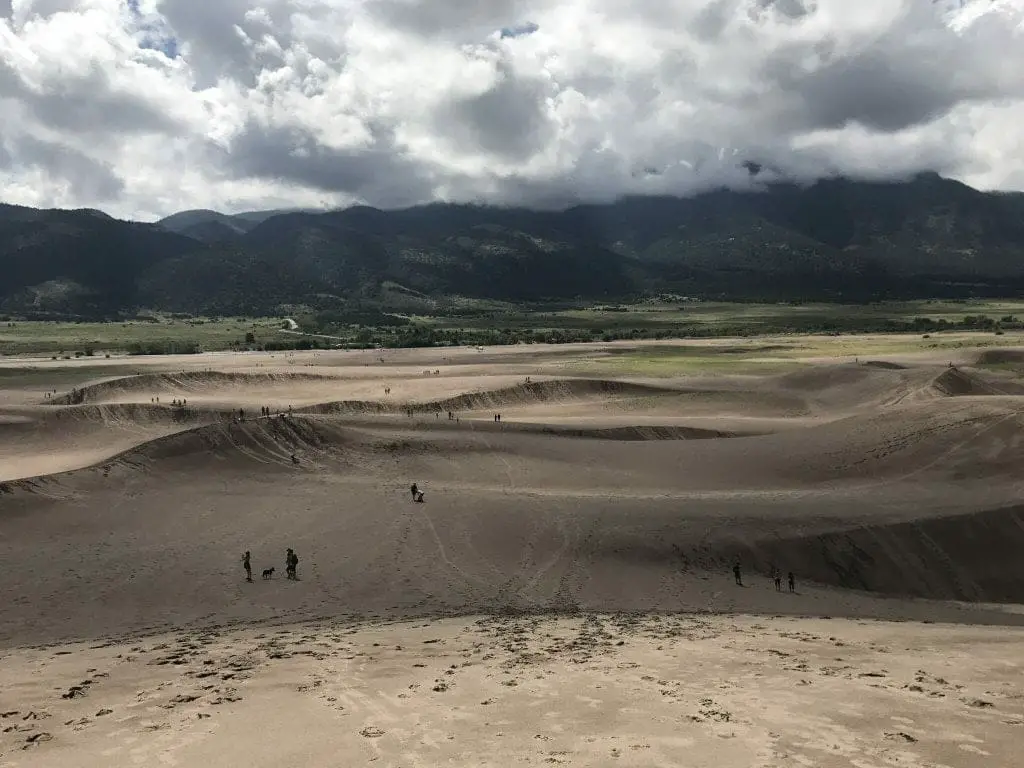
Visitor Center
Make a stop to peruse the displays and the gift shop, refill your water, or use the pristine restrooms. There are several exhibits that highlight the local flora and fauna you might encounter on the dunes, and the park rangers are exceptionally knowledgeable, ready to guide your park visit based on the current season and available time.
Don’t forget to request a map, check the weather forecast, and seek the rangers’ recommendations tailored to your trip’s duration and your planned activities. The shop is a delightful place to browse, where I picked up some fascinating books about the park’s history and ensured the kids received their National Park Pass stamps.
Exploring great sand dunes
When it comes to exploring, I recommend taking the time to venture into the dunes’ foothills regardless of your schedule. After visiting the visitor center and hydrating, make your way to the parking lot by the river and set off towards the dunes.
You don’t need to climb the towering sand dunes to appreciate them; simply crossing the stream leads you to the finer sand, inviting you to remove your shoes and immerse yourself in the scenery, experiencing the dunes up close.
For the more adventurous, following the trail blazed by others is the key to navigating these shifting sands. The ridgelines offer the most practical routes, as attempting to ascend the steep faces of the dunes is often an exercise in futility.
Climbing the dunes can be somewhat tricky – it’s a bit of a hike to some of the tall dunes nearby but undoubtedly worth it for the view.
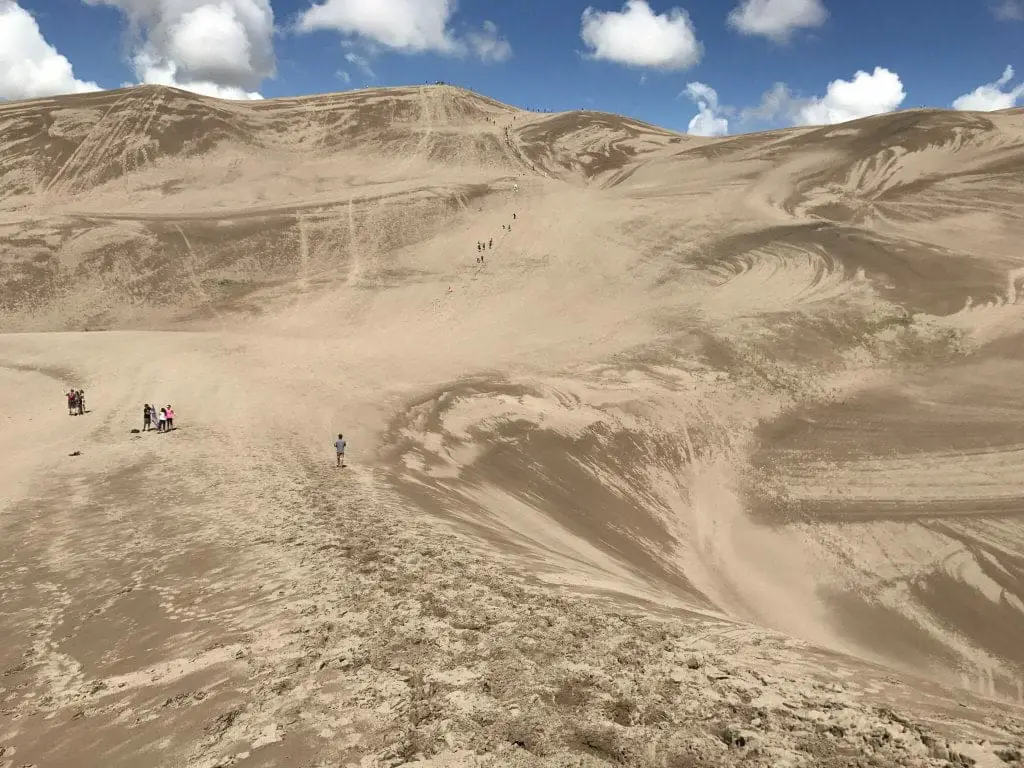
Every hiker I encountered around the dunes wore a smile as broad as mine. It wasn’t merely the glee of feeling children in North America’s largest sandbox; it was also a smile of awe and reverence in the presence of these colossal natural wonders. Truly, it’s a remarkable way to spend a day!
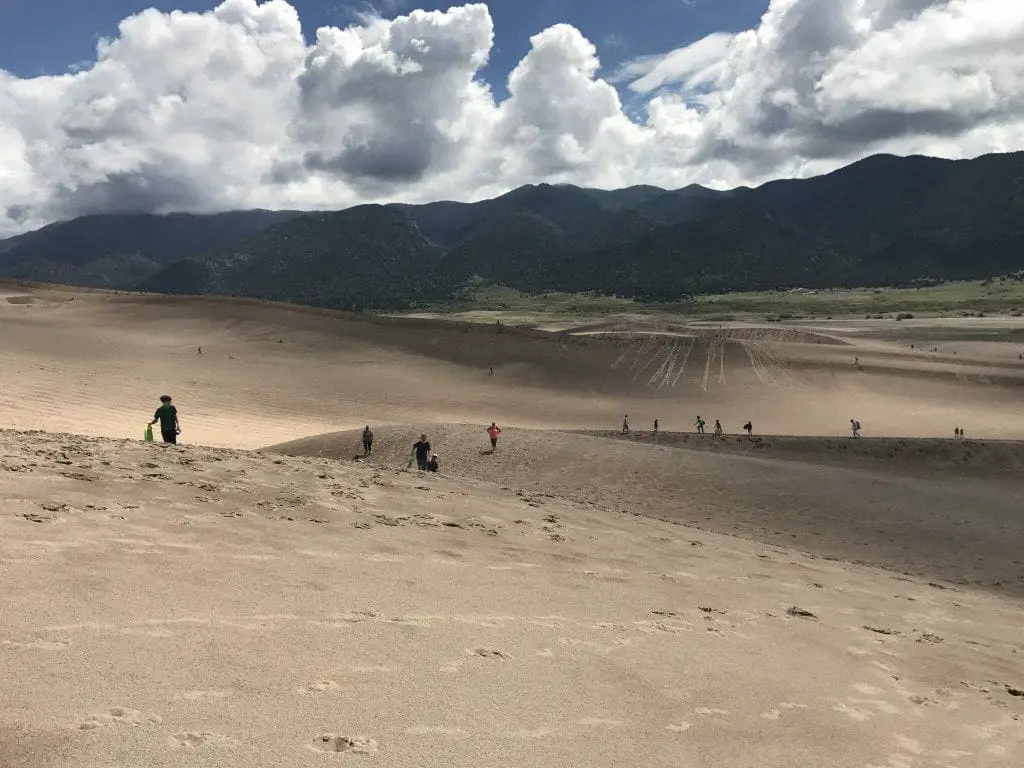
What to bring
For a day trip, ensure each person in your group has ample water. It’s advisable to wear breathable clothing that can get wet, especially if you plan to enjoy the water before the dry season begins in mid-June.
- Sunscreen
- Hat
- Sunglasses
- Comfortable shoes for sand/water crossing (I used Keens)
- Hiking Poles
- Water
- Snacks
When to visit
We completely lucked out with our trip to the Dunes. There was a light rainstorm the night before which kept the sand firm and packed and kept the water flowing in the seasonal stream upfront.
Show up early – the morning dew or morning rains make getting up the dunes much easier! I don’t think we would have made it to the first foothill dunes yet alone up to the top of some of the larger dunes if the sand hadn’t been wet and packed.
In the peak of summer temperature on the sand can reach over 150 degrees so plan well! If you are hiking in the hotter part of the day, be sure to research and know all the safety information of hiking in hot weather.
Things to do in Great Sand Dunes National Park
Nestled in the heart of Colorado, Great Sand Dunes National Park offers a unique blend of awe-inspiring scenery and exhilarating activities that cater to adventure seekers of all kinds. From the majestic heights of North America’s tallest sand dunes to the rugged trails of the surrounding wilderness, this park is a playground for those who dare to explore. Whether you’re gliding down sandy slopes, gazing at starlit skies, or navigating through remote landscapes, here are five must-do adventures that promise to make your visit unforgettable!
Conquer the crest: Hiking the Star Dune
Top Adventure at Great Sand Dunes: Hike America’s Tallest Dune – Hike to the top and enjoy the majestic views!
- Discover the tallest sand dune in North America: The Star Dune stands at approximately 750 feet and offers a challenging yet rewarding hike.
- Unparalleled views: From the summit, enjoy panoramic views of the entire dune field and the surrounding Sangre de Cristo Mountains.
- Best times to hike: Aim for early morning or late afternoon to avoid the midday heat and catch the best light for photographs.
If the day is hot and dry, the sand can be cumbersome to walk on, but if you start after a light rain shower or a morning dew, then the dense sand will allow you to go much further and climb to some of the summits. The secret is to simply follow the ridges (and the crowds) as the best means to climb the dunes.
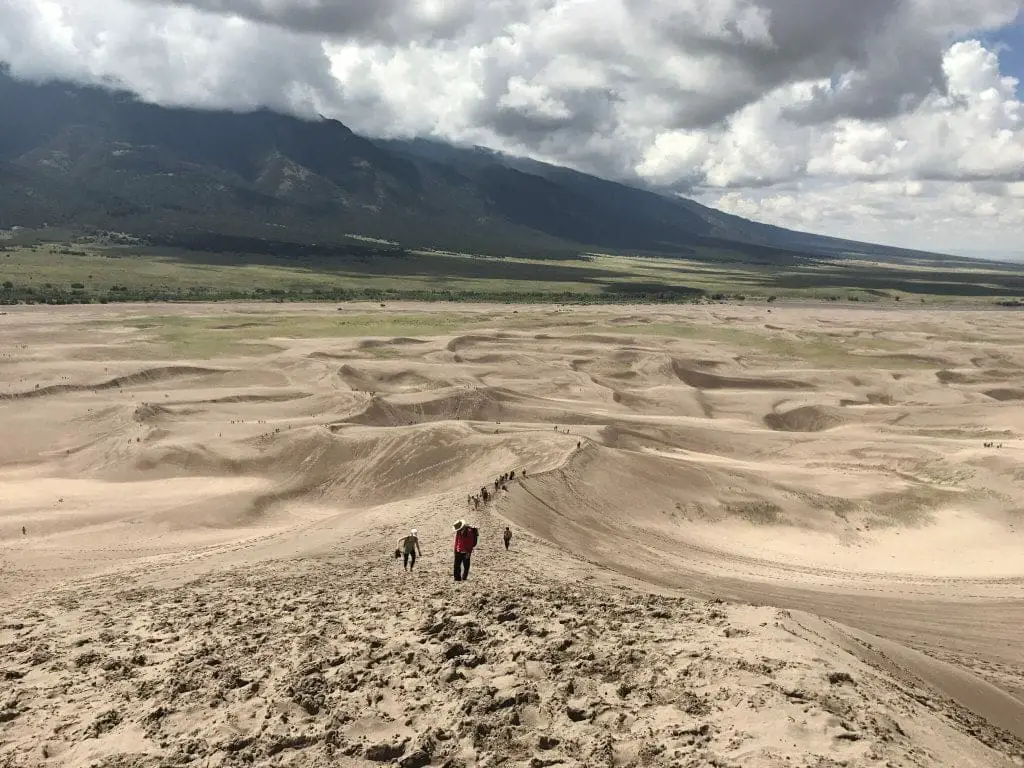
Once you’re on the top of one dune, you can turn around and see MORE behind you. That ridge of trees just beyond the sand is the Medano Creek – a seasonal river that flows from snowmelt.

I was amazed at how these dunes just go on forever. Pictures don’t do it justice. This is mother nature at work and you’re here being able to experience it first-hand. What a sight!
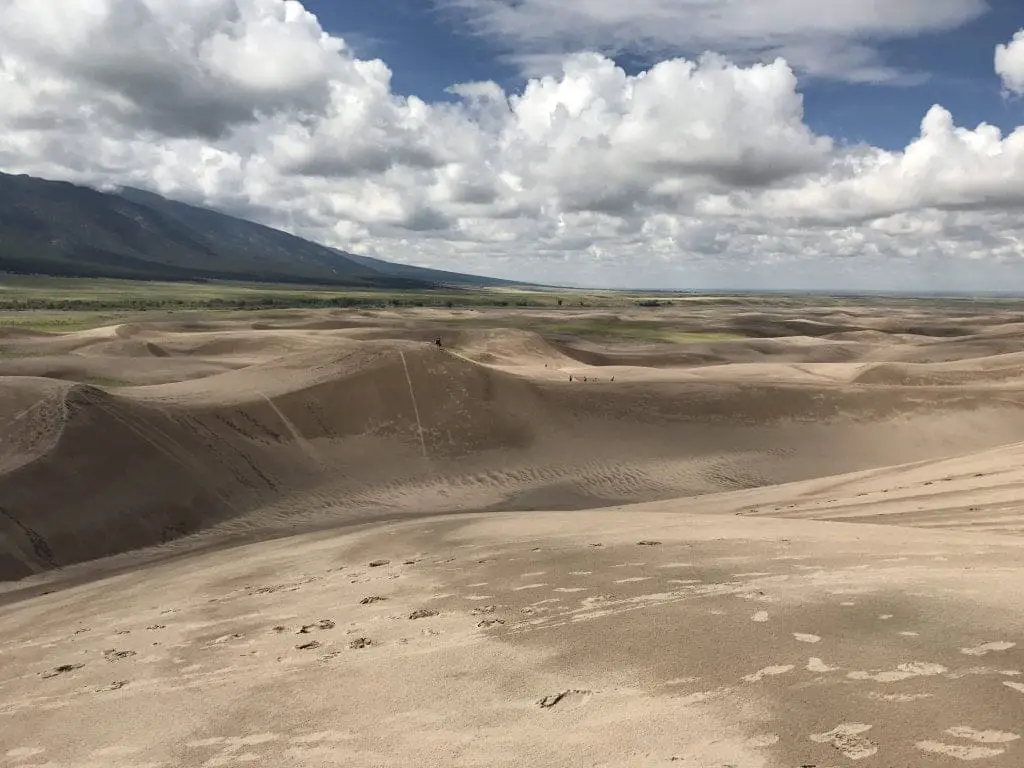
Ultimate Camping Experience at Great Sand Dunes National Park
Camping is available at the park in designated camping areas. The campsites had bathrooms, water, and some low vegetation providing shelter. If you’re looking for full service campsites, be sure to reserve your campsites in advance as the park will fill up. We didn’t stay in the park since they were booked full with a scout troop during our window. Primitive camping is allowed on the dunes with a permit.
We “kamped” at the Alamosa KOA for two nights during our stay at Great Sand Dunes National Park. Alamosa KOA has nice camp setups, Kamper Kabins if you wish to stay in a cute affordable cabin and plenty of RV spots for those in RV’s. We enjoyed the friendly staff, clean showers, washing & dryer facilities, and a dip in the pool. They also had a pizza shop in the camp store when we were there and kids had access to free popcorn which they enjoyed immensely.
- Scenic campsite options: Piñon Flats Campground offers a mix of standard and group sites nestled between dunes and mountains.
- Night sky wonders: The park’s remote location means minimal light pollution, making it perfect for stargazing.
- Access to park features: Conveniently located within walking distance to the dune field and the Medano Creek.
Slide the Sands: Sandboarding and Sand Sledding
Sandboarding is a favorite activity on the dunes. Unlike Sand Sledding that we did at White Sands National Monument, they don’t recommend disk sledding here since the sand has a different texture. There is a Sand-Board rental shop just before the park entrance where you can rent sandboards. (They look just like longer snowboards!)
- Year-round fun: Unlike traditional snowboarding, sandboarding can be enjoyed any time of the year, with spring and early summer being the peak seasons.
- Gear rentals available: No need to bring your own equipment; several local shops offer sandboards and sleds specifically designed for the sand.
- Tips for beginners: Start on smaller dunes to get the hang of the sport before tackling the taller dunes.
Off-Roading Adventure in Great Sand Dunes: Medano Pass Primitive Road
Great Sand Dunes features a 22-mile unpaved road with several river crossings and stretches of sand to traverse before reaching Medano Pass. This route is exclusively for street-licensed 4×4 vehicles, motorcycles, and bicycles.
During our visit, the off-roading trail was closed due to an ongoing recovery effort where a vehicle had become stuck in the sand, so caution is advised. It’s strictly for 4×4 vehicles. If you’re considering off-roading here, it’s wise to contact the ranger station beforehand to inquire about the weather and conditions.
At the time of our visit, there were no rental services available. However, companies offering Jeep rentals for trail exploration may be found at tourist spots where pamphlets are available.
- Challenging terrain: The road features a mix of sand, dirt, and creek crossings, suitable for experienced off-roaders with high-clearance, 4WD vehicles.
- Explore remote areas: The road leads to less-visited parts of the park and the adjacent Rio Grande National Forest.
- Preparation is key: Check vehicle readiness, pack emergency supplies, and verify road conditions at the visitor center before heading out.
Nighttime Wildlife Encounters at Great Sand Dunes
Great Sand Dunes National Park is not only famous for its sweeping landscapes and towering dunes but also as a vibrant habitat for a variety of wildlife, ranging from the tiny insects that skim the surface of the sand to the elusive kangaroo rats that hop under the moonlit skies. For nature enthusiasts and wildlife watchers, the park offers a unique glimpse into the life that thrives in this seemingly inhospitable environment.
One of the best ways to discover the local fauna is through the park’s guided wildlife walks, particularly the nighttime tours. These walks are led by knowledgeable park rangers who help visitors spot and understand the nocturnal animals that make the dunes their home. As the sun sets and the temperature drops, creatures like the Ord’s kangaroo rat, which has adapted to the harsh dune environment, become active. These tours not only offer a chance to see these unique animals but also to learn about their adaptations and roles in the ecosystem.
For those interested in exploring on their own, dawn and dusk are ideal times for wildlife watching. The cooler parts of the day encourage more animal activity and provide opportunities to see a broader range of species. Keep an eye out for tracks in the sand—these can lead you to active burrows or feeding sites. Binoculars are a must-have to catch sight of birds such as the sandhill cranes or the secretive burrowing owls. Additionally, local outfitters outside the park offer rentals and equipment that can enhance your wildlife watching experience, from powerful binoculars to guidebooks that detail the park’s biological diversity. Whether guided or on your own, experiencing the wildlife of Great Sand Dunes National Park can add an enriching layer to your adventure in this unique natural playground.
Getting to Great Sand Dunes np
Great Sand Dunes NP is Located in Southern Colorado at 11000 CO 150, Mosca CO 81146
You can click the “Directions” link on the map below to map from your location.
Website: Great Sand Dunes National Park & Preserve
Are there any hotels near Great Sand Dunes National Park?
Great Sand Dunes Lodge is the closest Hotel to the park but the odds are unless you book early, it will be full. For Hotels, Alamosa is the closest city and it will be about a 45-minute drive to get to the park.
Can you camp on the dunes at Great Sand Dunes National Park?
ou must obtain a backcountry permit to camp on the dunes. These permits must be obtained in person during backcountry office hours. There are multiple full-service type campsites available on the main park access areas.
Are dogs permitted in great sand dunes national park trails or backcountry camping?
No, dogs are not permitted in backcountry trails or backcountry camping.
When is peak season at Great Sand Dunes?
Peak season is during early spring through June when Medano Creek’s is flowing through the park and holiday weekends.
When is the best time to visit Great Sand Dunes National Park?
If you’re planning to hike, camp, or take a multi-day trip, early spring is ideal for spending the most time in the park, with milder temperatures and plentiful water sources for cooling off or filtering for drinking. For a day visit, aim to arrive early to avoid the heat. We were fortunate to experience a morning rain shower just before our arrival, which compacted the snow and significantly eased our trek up the dunes. Timing your visit shortly after rain and before the afternoon sun intensifies allows for a more comfortable exploration of the dunes. However, once the dunes become hot, the sand can be incredibly challenging to navigate.
FAQ
Pin It!
Bookmark this on Pinterest and share it with your friends! Let them know about this must-visit National Park!
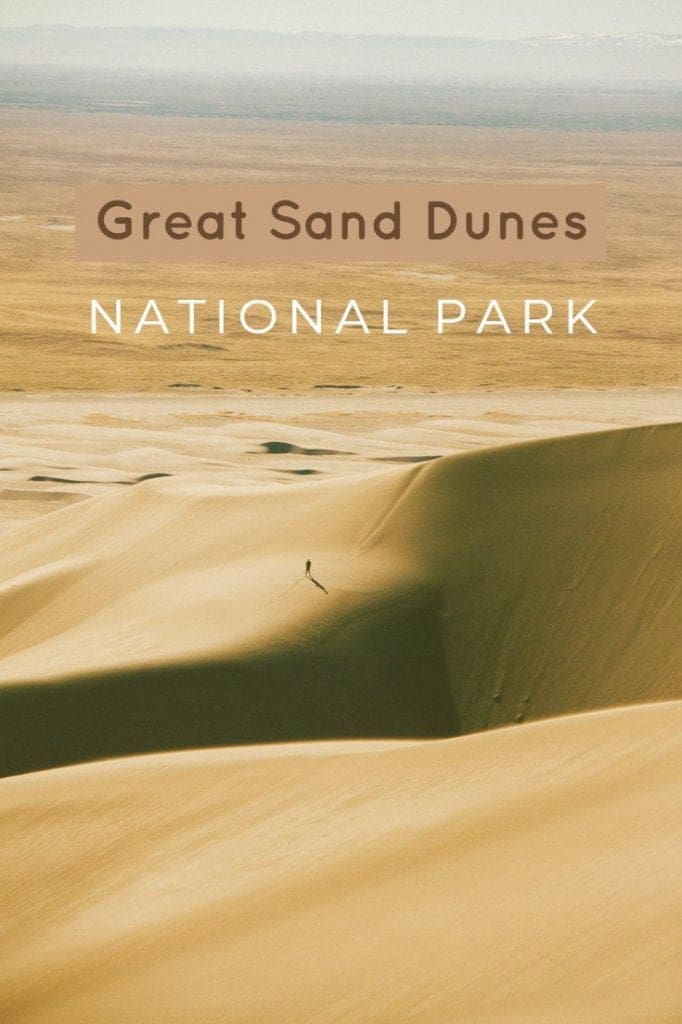

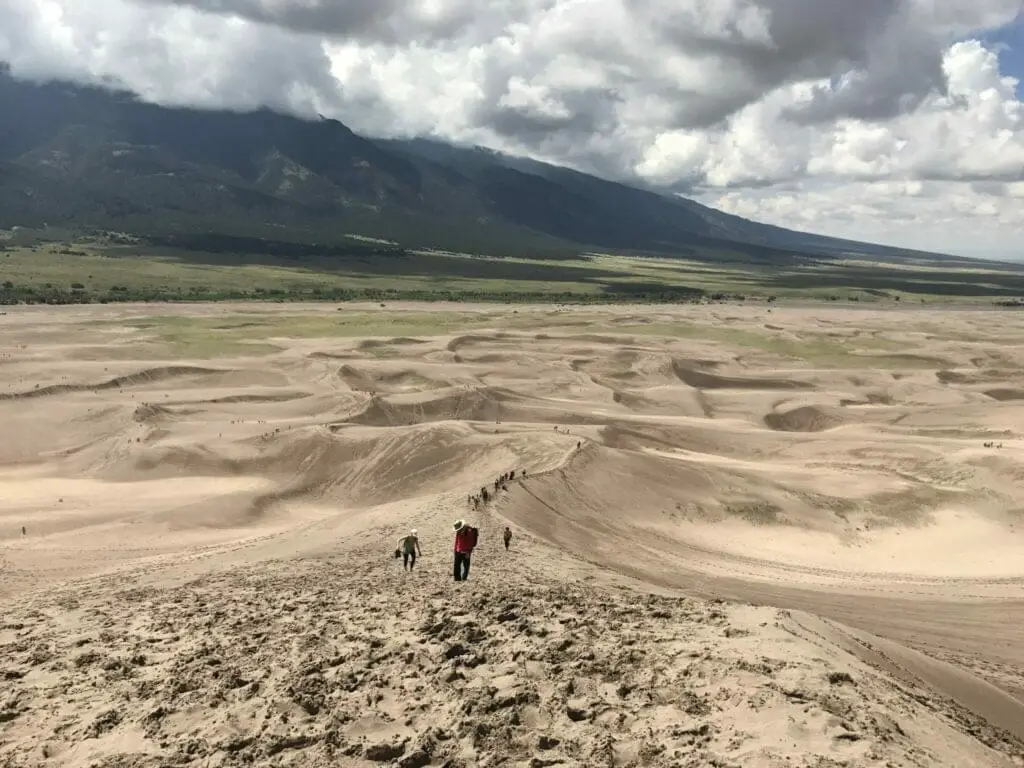
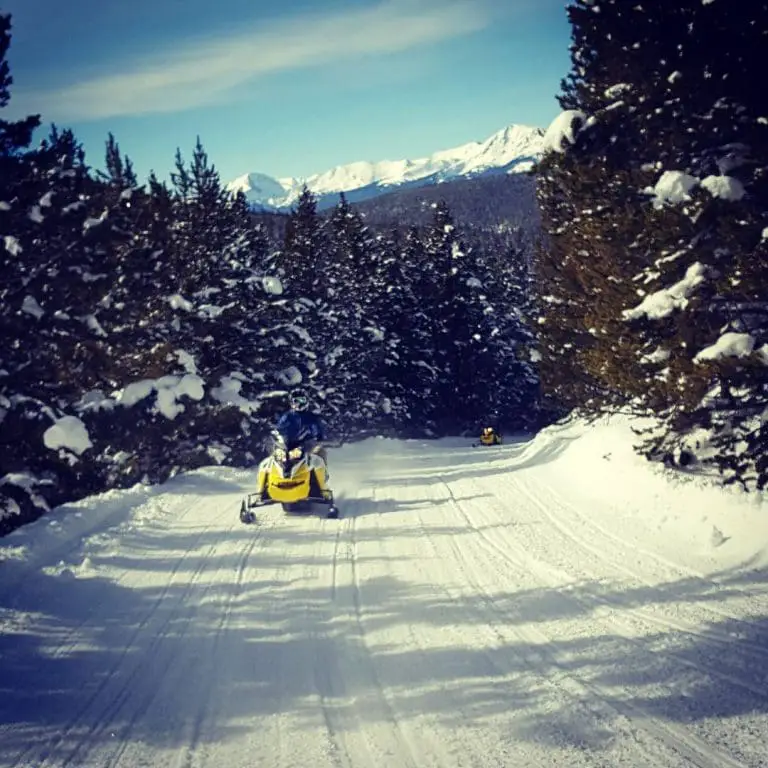
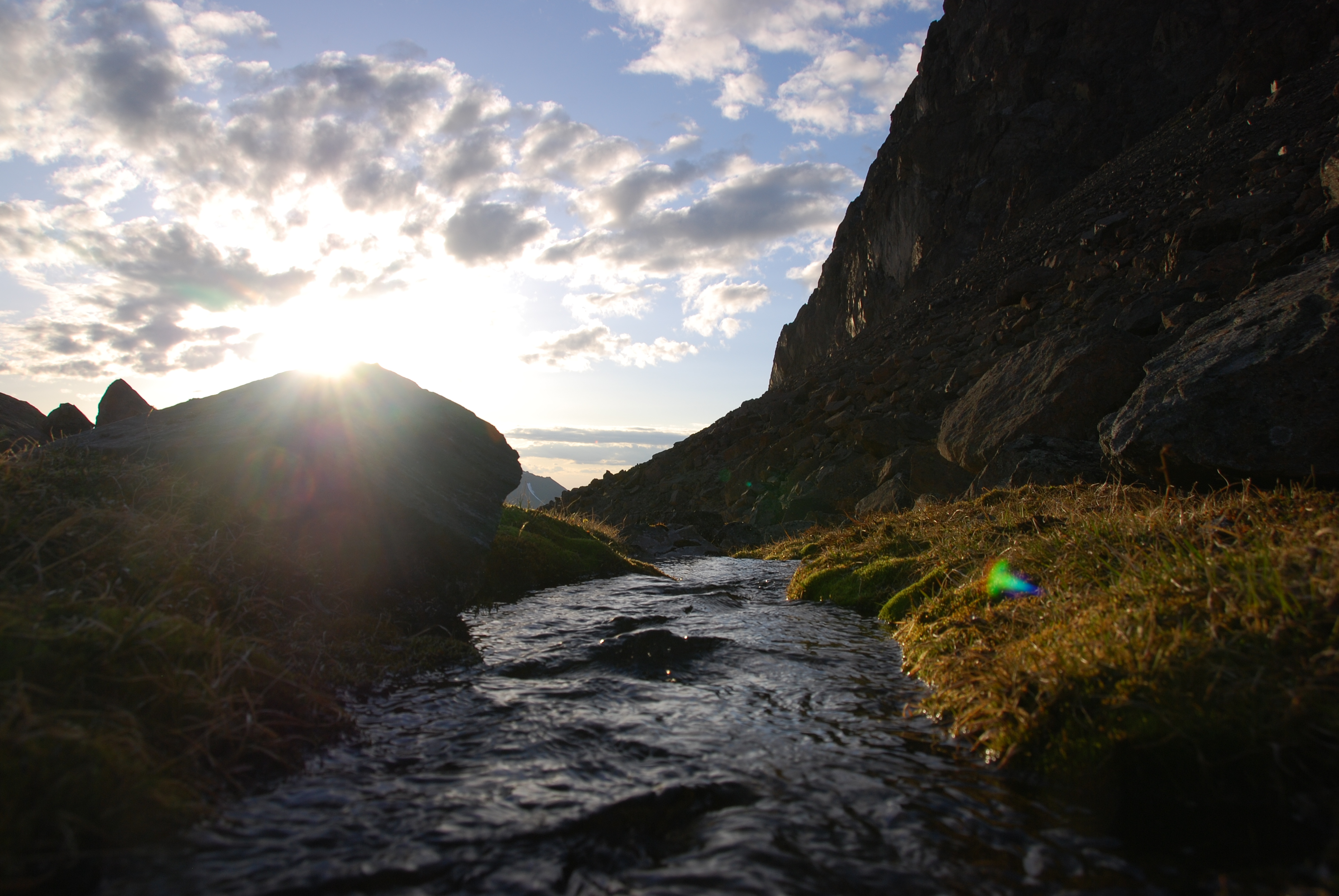

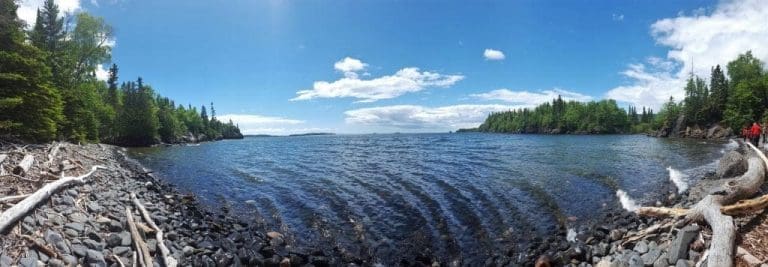
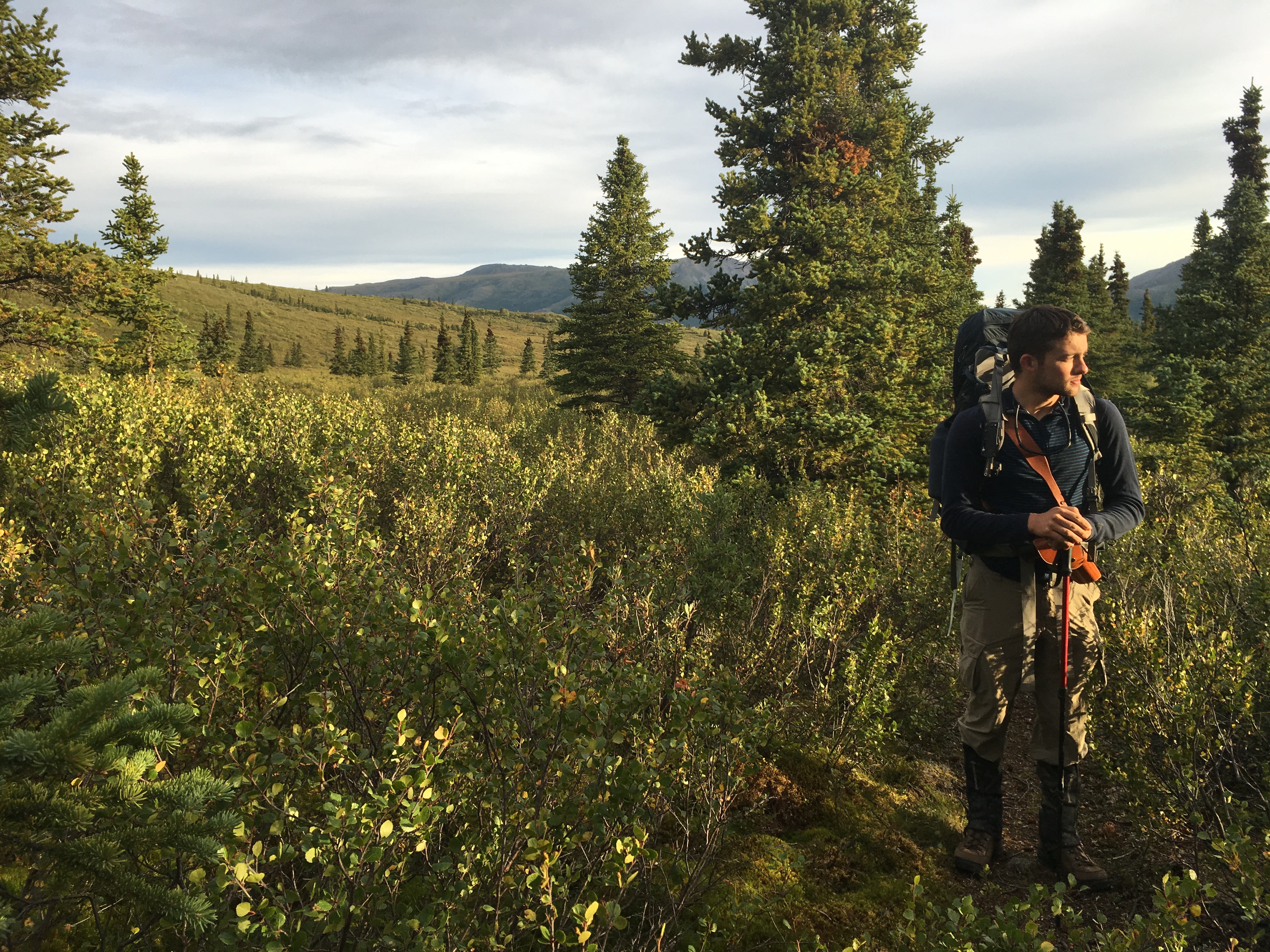
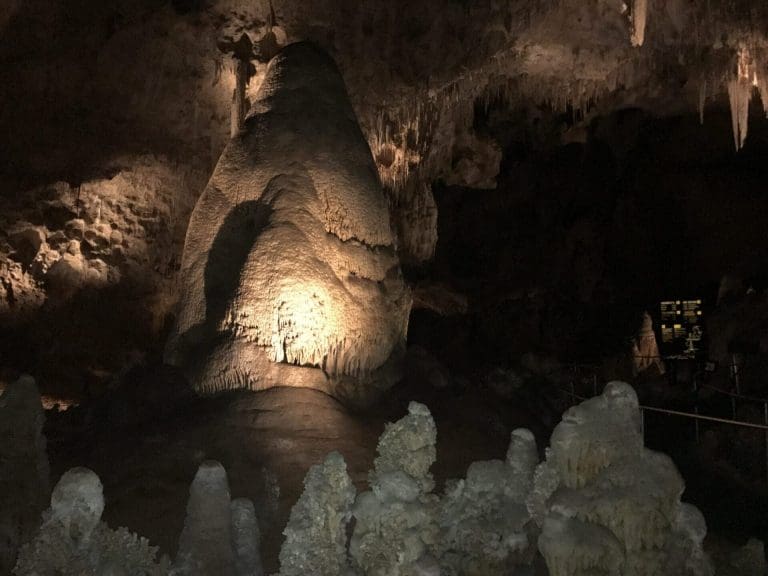
Hey, cool blog post!
If I’ve got the timings right, I think we were on the Medano Pass Primitive Road when it was closed while you were there (end of July). We weren’t stuck, but the trail had completely washed out and we couldn’t go any further! A flash flood came through and caused huge destruction to the trail – the Chief Ranger said it was the worst trail damage he’d ever seen there. One of the Ranger’s trucks (a Ford Raptor) did get stuck, and the excavator broke the tow strap trying to pull them out. We left our truck on the trail overnight and had to come back for it the next day. I think the trail was closed for about 3 weeks after that.
If you want to see what the trail looked like, take a look at our Instagram (@AdventurousWay) photo: https://www.instagram.com/p/B0TDsVlBENB/